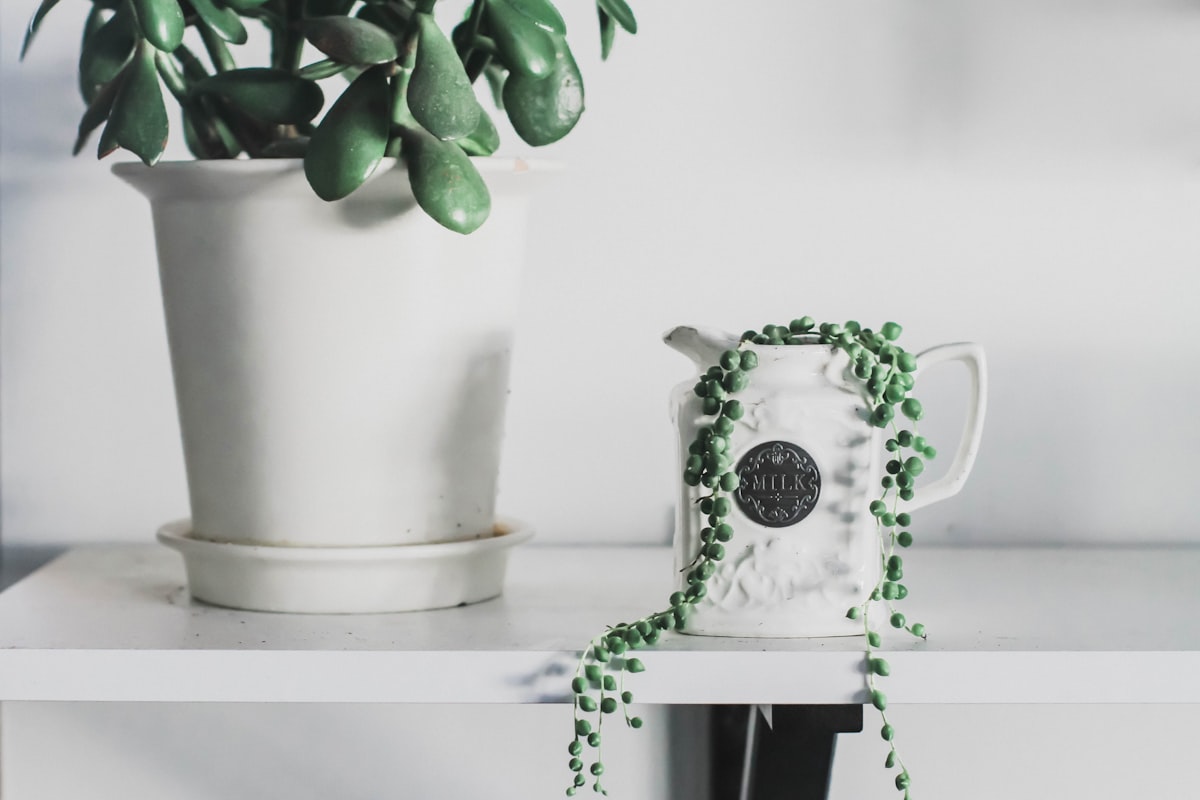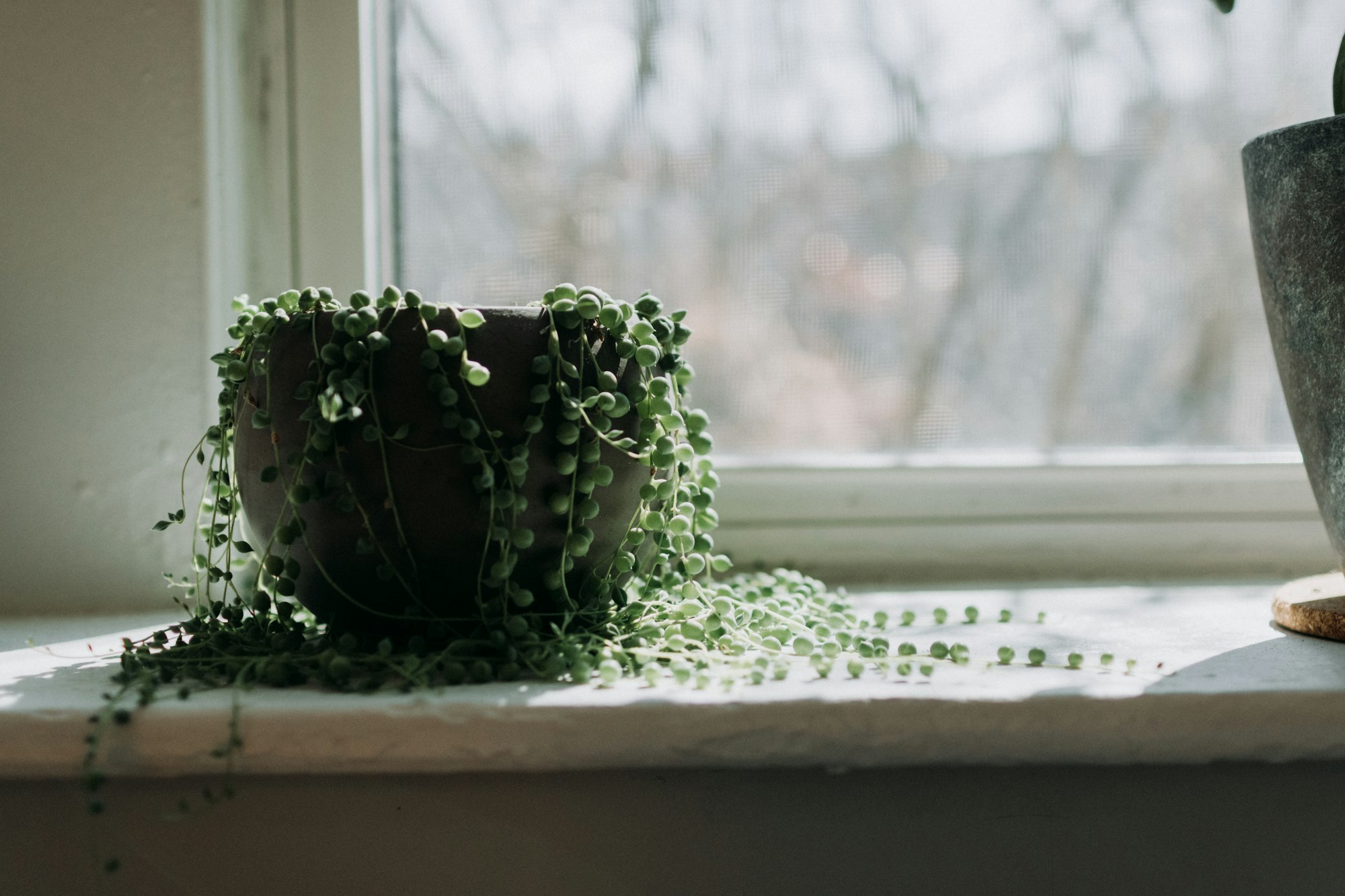How to Grow String of Pearls
String of Pearls is a beautiful, unique succulent that can be an eye-catching addition to your indoor garden.

Table of Contents
Known for its cascading vines full of bead-like leaves, this plant adds visual interest and is relatively easy to grow and care for.
To start growing your String of Pearls, you'll need a well-draining pot and a loose, airy cactus or succulent potting medium to ensure proper drainage.
Planting your succulent in the right conditions can set it up for a healthy and vibrant growth journey.
Remember to water thoroughly, but only when the potting medium is dry to prevent overwatering, and provide a consistent temperature of around 70° - 80°Fahrenheit (21 - 26.6 °Celsius) for optimal growth.
About String of Pearls

String of pearls, scientifically known as Senecio rowleyanus, is an eye-catching succulent plant known for its unique appearance.
Native to Africa, this plant features cascading strings of bead-like, pea-shaped leaves, earning it common names like string of beads and even the more whimsical string of watermelons, string of dolphins, and string of tears.
The string of pearls plants belong to the Senecio genus and display similarities to other succulents like String of bananas (Curio radicans), String of watermelons (Curio herreanus), and String of dolphins (Curio peregrinus).
As a popular decorative choice for indoor and outdoor settings, these succulents require proper care and the right environment to thrive, including adequate sunlight, well-draining soil, and appropriate watering habits.
Growing String of Pearls
Choose a well-draining container with drainage holes to prevent root rot.
Select a potting mix such as a cactus potting mix or a mixture of sandy soil, sharp sand, and compost for optimal drainage and root health.

Place your string of pearls in a location that receives bright, indirect light for six to eight hours daily.
Keep the plant in direct sunlight during the morning and move it to an area with indirect or partial shade during the afternoon.
Root your string of pearls through stem cuttings placed in water or directly in the soil mix.
Water it carefully to avoid overwatering and maintain a temperature range of 70° - 80°Fahrenheit (21 - 26.6 °Celsius) for healthy growth.

Caring for String of Pearls
Sun and Temperature
Your String of Pearls plant thrives with a combination of direct and indirect sunlight for a total of 6-8 hours daily.
Place it in direct sunlight during the softer morning hours and switch to a spot with diffused, indirect light or partial shade during the harsher afternoon hours.
Optimal temperatures lie between 65-80°F (18-27°C) in warmer months and 50-60°F (10-16°C) during its dormant winter phase.
Be cautious of exposing the plant to prolonged full sun, as it can cause sunburn on the leaves.
Water and Humidity
Water your String of Pearls thoroughly when the soil is completely dry, usually once every 2-3 weeks. Be mindful not to overwater, as this can lead to root rot.

Provide a well-ventilated space for your plant to cope with humidity and avoid misting its leaves.
Soil
Choose a well-draining soil with a cactus or succulent soil mix.
Adding fine, coarse gravel will improve drainage and prevent root rot caused by excess moisture.
Fertilizer
During the growing season, provide your plant with a balanced liquid fertilizer, diluted to half-strength, and apply it on the soil every month.
Refrain from fertilizing during the dormant winter months to avoid harming the plant's growth.

Repotting
When your String of Pearls outgrows its current pot, repot it carefully into a slightly larger one. Ensure the new pot has adequate drainage holes.
This process is recommended every 1-2 years, preferably during the growing season.
Pruning and Propagation
Regularly prune your plant by removing dead or damaged leaves to promote new growth.
To propagate, take a 5-inch stem cutting and remove half of the pearls, then place it in water to root or plant it directly into a cactus or succulent soil mix.
New plants will form in a few weeks. Happy gardening!
Troubleshooting Plant Problems
Growing Problems
Underwatering: If your String of Pearls plant begins to show shriveled leaves, you may be underwatering it.
Young succulents need more water than mature ones, so adjust your watering accordingly.
Overwatering: Overwatered String of Pearls plants are at risk of root rot; yellowing leaves can indicate this problem.
To avoid overwatering, ensure proper drainage and only water your plant when the soil is dry.
Pests and Diseases
Pests: String of Pearls plants can attract insects such as mealybugs and spider mites.
To treat pests, remove affected leaves and use an insecticidal soap or neem oil to prevent further infestations.
Diseases: Root rot is a common disease due to overwatering. Ensure your plant has good drainage and water only when necessary to prevent disease.
Companion Planting
When planting String of Pearls, consider pairing it with other succulents and plants that share similar needs, such as low water requirements and preference for well-draining soil.
Good companion plants include Echeveria, Kalanchoe, and Sedum.
Conclusion
In order to successfully grow and maintain your String of Pearls plant, always pay attention to factors such as soil, light, temperature, and watering.
By doing so, you will be able to enjoy its unique beauty for years.
Remember the importance of regular pruning and how to properly propagate your plant, which will ensure a healthy and thriving String of Pearls.
Remember, with care and patience, you can cultivate this fascinating plant in your home or garden.
Frequently Asked Questions
What are the light requirements for String of Pearls?
String of Pearls thrive in bright, indirect sunlight. Avoid placing them in direct sunlight, which may cause leaf sunburn.
What type of soil is best for growing String of Pearls?
A well-draining soil mix, such as a cactus or succulent mix, is ideal for String of Pearls. This helps prevent root rot and allows the plant to dry out quickly between waterings.
How often should I water String of Pearls?
Water your String of Pearls when the top inch of soil feels dry. Overwatering can lead to root rot, so let the soil dry out properly between waterings.
Which type of fertilizer is suitable for String of Pearls?
A balanced liquid fertilizer diluted to half strength is suitable for String of Pearls.
Apply the fertilizer during the growing season, typically spring and summer, every 4-6 weeks.
Can I grow String of Pearls from a single pearl?
No, it's best to propagate a String of Pearls from stem cuttings with multiple sets of pearls. These cuttings have a higher chance of successful root development and growth.
How to effectively grow String of Pearls indoors?
To grow String of Pearls indoors, provide them with bright, indirect light and well-draining soil in a small pot.
Be mindful of their watering needs and consider using a balanced liquid fertilizer during their growing season.



